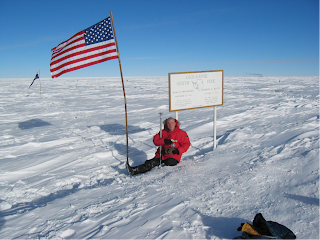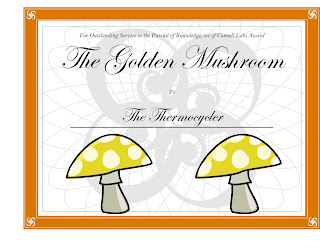Looking back at the many posts in our archives thus far it springs to mind that we really havn't discussed much of what we do here. We have mentioned a few areas that we get samples from and mentioned soil washing breifly, but those are just pieces of the puzzle that is our work. Today, we would like to try and describe the big picture of what we do.
Our process is a little bit time consuming but is fairly strait forward.
Step one is pretty simple. We need to get our fungi. If you know what our blog is called then you can probably guess where our fungi come from (Hint: The answer is Antarctica).
Dr. Connell (our fearless leader) has taken several trips down to the Antarctic to collect soil.
Pictured: Dr. Connell and soil.
Why is the soil important? Because it is where all of the microscopic fungi live. Dr. Connell collects soil samples from various areas and then ships them back to the rest of us back here in Maine.
You know, Maine.
We take these soil samples and add a bit of water to them and then put them in our shaker.
SUPER ADVANCED SHAKING TECHNOLOGY!!!
The shaker shakes the sample around and gets all of the fungi suspended in the water. We then take this water and dump it onto a plate (petri dish) with some sort of nutrient on it. We end up with something that looks like this.
Pretty exciting huh?
In the Antarctic nutrients are very limited. The plate, on the other hand is covered in nutrients. It's sort of like throwing a starving man into a room made out of hamburgers. The fungi take advantage of these nutrients and grow quickly. Before long, we have little colonies of fungi growing all over the plate.
Once the colonies have grown to a visible size, we move the colony to a new sterile plate using a streamlined woden disposibal cell extraction mechanism.
Also known as a toothpick.
We allow the cells to grow on their new plate for a while. Once they have sufficiantly grown, we take a big clump of the cells and preform what is known as a DNA extraction on them. A DNA extraction is basicly what is sounds like. It's like you had a bag of peanut m&m's and only wanted the peanuts. We want the DNA inside of the cells, but none of the cell stuff. A DNA extraction does that for us. I won't go into specifics because it's kind of a long and boring procedure.
Now we have DNA. As you may or may not know, DNA is essentially the instruction booklet for making an organism.
Pictured: DNA
Now, DNA, is big. We can't just sit down and read the whole thing to figure out what it is. To save time, we look at one specific pieces of the DNA to identify the organism. We look at that piece of DNA and compare it with pieces of DNA from known organisms. If the piece matches the same piece from one of our known organisms, we know they are the same species.
If you didn't understand that, think about it this way. Suppose you had a book, but you didn't know what the book was called and were too lazy to read it. Now suppose that you had a strange habit of ripping out page 52 in every book you found. You could look at page 52 in your unknown book and compare it with the pages in your collection. If it matches one of your pages, you know what book you have.
Pictured: You
Now, simple as all of that sounds, there is one little hitch in the plan. We can't just flip to a specific page of DNA because it's really, really small. So, what do we do?
Well we take our extracted DNA and preform a PCR on it. PCR stands for Polymerase Chain Reaction. It's pretty cool how it works but I won't go to far in depth on it. In short, what it does is it goes through the strand of DNA and replicates the "page" that we want. It then does that again, and again, and again, and so on. By the time the reaction is done we have thousands of copies of that one "page".
Pictured: PCR
We take these thousands of copies and sequence them. Sequencing is basically a way of taking these copies and turning them into a format that we can read. We can then compare what the "page" says with "pages" that we know. When we find a match, we know what the species is. If we don't find a match, chances are, we have a new species.
We don't stop there though. We also take some of the copies and run an ARISA on them. ARISA, is another process that I won't go into details on, but in short it gives us a graph that looks something like this.
Note: Not actual Data.
I know what you are thinking right now. "Whoop-de-doo".
Here is what is important about this graph. Where the peak is, is specific to that organism.
We are gathering ARISA data for as many organisms as we can. We are making a library of data.
Our hope is that in the future we will be able to take a pure soil sample, extract DNA from it, run a PCR on it, and then run an ARISA to get a graph that looks something like this.
Note: Still not real data.
By comparing peaks with the peaks of known samples we can identify the organisms in the soil. This is handy for a number of reasons.
1. It's way cheaper than sequencing every organism.
2. It's way faster than sequencing every organism.
3. It allows us to study species diversity. We will be able to look at the species present and one location, and see if they are the same species found in a different location, and if they are not, how much they vary.
Well, that's what we do. I hope that you all feel better informed about what we actually do, and that we use our grant money for actual work and not tie dye.
By Ben Segee





















































